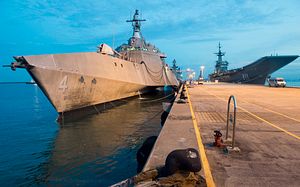On June 12, the U.S. Navy announced that a U.S. warship was conducting a port visit to Vietnam’s Cam Ranh Bay for maintenance. The engagement was the latest in a series that demonstrates the progress that Washington and Hanoi are making in their defense relationship even amid the uncertainty that remains over U.S. President Donald Trump’s broader Asia policy.
As I have noted before, U.S.-Vietnam defense relations have been strengthening over the past few years as part of a broader comprehensive partnership signed in 2013 under former U.S. President Barack Obama. This includes exchanges, exercises, and capacity-building in the maritime security domain with Vietnam’s coast guard as Hanoi continues to contend with Beijing’s assertiveness in the South China Sea (See: “US-Vietnam Defense Relations: Problems and Prospects”).
One outlet for this defense collaboration is U.S. ship visits to Cam Ranh International Seaport, a new international port facility capable of receiving foreign warships that Vietnam had opened back in March last year. The port, located in Cam Ranh Bay, a deep-water harbor in central Vietnam along the South China Sea that Washington had used as a base during the Vietnam War, has since seen visits from a string of countries, including Japan, France, China, the Philippines, and Singapore.
U.S. vessels began docking for maintenance there starting last September, and other interactions have followed since (See: “Vietnam Unveils Port Facility For Foreign Warships in Cam Ranh Bay”). Indeed, just earlier this month, the Arleigh Burke-class guided-missile destroyer USS John S. McCain was at a “routine technical stop” in Cam Ranh International Port.
During the visit, U.S. Senator John McCain visited the vessel as part of a broader congressional delegation, which had meetings with Vietnamese officials including President Tran Dai Quang, Defense Minister Ngo Xuan Lich, and National Assembly Chairwoman Nguyen Thi Kim Ngan. The U.S. Embassy in Vietnam called the engagement “a strong symbol of the positive trajectory of the U.S.-Vietnam comprehensive partnership.”
The presence of the USS John S. McCain – commissioned in 1994 and named after McCain’s father and grandfather who were involved in the Pacific Theater during World War II – was especially significant within the context of the evolution of the relationship. This is not just because of McCain’s role in the normalization process of U.S.-Vietnam relations, but because, back in 2016, the McCain along with the submarine tender USS Frank Cable were the first U.S. Navy vessels to visit Cam Ranh International Port since it opened back in March 2016.
That visit also came amid a flurry of activity in the U.S.-Vietnam defense relationship in May which I had written about recently, even in the face of continuing challenges both sides face in forging closer ties (See: “US Vietnam Ties Under Trump in the Spotlight with Premier’s Visit”). This included the transfer of a U.S. coast guard cutter and six 45-foot American Metal Shark patrol boats to the Vietnam Coast Guard (VCG) ahead of Vietnamese Prime Minister Nguyen Xuan Phuc’s visit to the White House. Vietnam’s defense minister is expected to visit the United States later this year as well as both sides discuss opportunities to advance their ties.
On Monday, in another interaction in the U.S.-Vietnam defense relationship, the U.S. Navy confirmed that the USS Coronado, an Independence-class littoral combat ship (LCS), was conducting an Expeditionary Preventive Maintenance Availability in Cam Ranh from June 11-15 as part of a “technical visit” to the international port.
The technical port visit was the first demonstration of expeditionary maintenance capabilities for the rotationally deployed LCS, Task Force 73, the U.S. Navy task force of the Seventh Fleet which coordinates exercises for Southeast Asia, said in a statement. Thought the normal LCS supply and maintenance hub is in Singapore, where the U.S. Navy plans to simultaneously deploy two of the ships in 2018, additional hubs are important to boosting support for the vessels which have run into some challenges since being originally rolled out.
“This technical visit advances our expeditionary maintenance capabilities and further strengthens our partnership with Vietnam,” Rear Adm. Don Gabrielson, the commander of Task Force 73, said in a statement. “Technical visits benefit both nations and increase our geographic flexibility in repairing and maintaining a high state of readiness in our ships.”

































